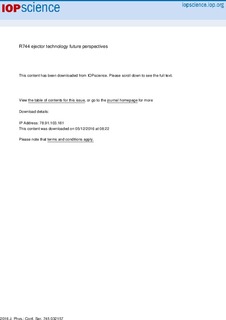| dc.contributor.author | Hafner, Armin | |
| dc.contributor.author | Banasiak, Krzysztof | |
| dc.date.accessioned | 2017-01-13T15:04:12Z | |
| dc.date.available | 2017-01-13T15:04:12Z | |
| dc.date.created | 2016-12-05T09:22:23Z | |
| dc.date.issued | 2016 | |
| dc.identifier.citation | Journal of Physics: Conference Series. 2016, 745, 032157 | nb_NO |
| dc.identifier.issn | 1742-6588 | |
| dc.identifier.uri | http://hdl.handle.net/11250/2427290 | |
| dc.description.abstract | Carbon Dioxide, CO2 (R744) was one of the first commonly applied working fluids in the infancy of refrigeration more than 100 years ago. In contrast to ammonia it mainly disappeared after the first generation of synthetic refrigerants have been introduced to the market after 1930. One reason was that the transition from low-rpm belt driven compressors towards the direct electrical motor driven compressors (50-60 Hz) was not performed for CO2 compressors before the revival introduced by Gustav Lorentzen in the 90is of last century. Since 1988 an enormous R & D effort has been made to further develop CO2 refrigeration technology in spite of the opposition from the chemical industry. Today CO2 refrigeration and heat pumping technologies are accepted as viable and sustainable alternatives for several applications like commercial refrigeration, transport refrigeration, vehicle air conditioning & heat pumping, domestic hot water heat pumps and industrial applications. For some applications, the current threshold to introduce R744 technology can be overcome when the system design takes into account the advantage of the thermo dynamical- and fluid properties of CO2. I.e. The system is designed for transcritical operation with all it pros and cons and takes into consideration how to minimize the losses, and to apply the normally lost expansion work. Shortcut-designs, i.e. drop in solutions, just replacing the H(C)FC refrigeration unit with an CO2 systems adapted for higher system pressures will not result in energy efficient products. CO2 systems do offer the advantage of enabling flooded evaporators supported with adapted ejector technology. These units offer high system performances at low temperature differences and show low temperature air mal-distributions across evaporators. This work gives an overview for the development possibilities for several applications during the next years. Resulting in a further market share increase of CO2 refrigeration and heat pump systems, as energy efficient alternatives to current systems not applying natural working fluids. | nb_NO |
| dc.language.iso | eng | nb_NO |
| dc.publisher | IOP Publishing | nb_NO |
| dc.rights | Navngivelse 4.0 Internasjonal | * |
| dc.rights.uri | http://creativecommons.org/licenses/by/4.0/deed.no | * |
| dc.title | R744 ejector technology future perspectives | nb_NO |
| dc.type | Journal article | nb_NO |
| dc.type | Peer reviewed | nb_NO |
| dc.source.volume | 745 | nb_NO |
| dc.source.journal | Journal of Physics: Conference Series | nb_NO |
| dc.identifier.doi | 10.1088/1742-6596/745/3/032157 | |
| dc.identifier.cristin | 1408067 | |
| dc.description.localcode | Content from this work may be used under the terms of the Creative Commons Attribution 3.0 licence. Any further distribution of this work must maintain attribution to the author(s) and the title of the work, journal citation and DOI. | nb_NO |
| cristin.unitcode | 194,64,25,0 | |
| cristin.unitname | Institutt for energi- og prosessteknikk | |
| cristin.ispublished | true | |
| cristin.fulltext | original | |
| cristin.qualitycode | 1 | |

